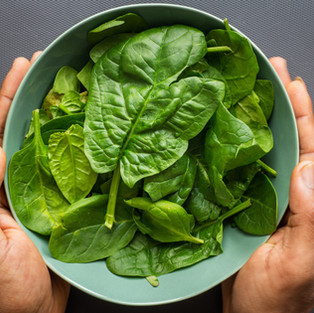Food Stats: Spinach
- Linked Fit

- Jul 21, 2020
- 2 min read
Updated: Jan 10, 2021
Overview
The word “spinach” has an uncertain origin but it is thought to be derived from the French word, “espinache.”
Spinach is thought to have originated in ancient Persia 2000 years ago and was brought to other countries.
It is native to the central and western parts of Asia and is a part of the Amaranthaceae family of veggies!
Spinach is an annual plant and the plant itself can grow to be as high as 1 foot (30cm) tall!
Spinach plants surprisingly bud flowers! They are a yellow-greenish color and almost blend in with the plant. They contain seeds to pollinate.
In 2018, the total production of spinach on a global scale was 26.3 million tonnes! One metric tonne is equal to 2,204.6 pounds. That is definitely a ton of spinach.

The Look
Spinach leaves can have many different looks! They are green, leafy, and can range from simple triangles to ovals.
The leaves are usually larger the higher up they are on the plant. Where the plant stems from the ground the leaves are smaller.
Nutrition
Besides being 91% water, spinach also contains these important micronutrients:
Vitamins E, A, K, & many B vitamins
Calcium
Iron
Potassium
Manganese
Benefits
B vitamins promote a healthy metabolism and contribute to overall energy balance.
Vitamin E primarily acts as an antioxidant by quenching free radicals in the body. In addition to being an antioxidant, it protects and maintains the membranes of cells in the body.
Vitamin A promotes eye health, cell differentiation, bone development, and immunity!
Vitamin K promotes healthy blood clotting.
Calcium plays a large role in healthy bone formation along with nerve transmission and muscle contraction.
Potassium is generally associated with low blood pressure and lowering the chance of stroke.
Manganese takes part in bone, cartilage, and connective tissue synthesis.
Serving Size
About 100 grams or ½ a cup of spinach contains 23 calories.
About 3.6 grams of carbohydrates.
About 2.9 grams of protein.
About 0.4 grams of fat.
About 2.2 grams of fiber.
Use & Cooking
Spinach can be used in a variety of dishes making it a good veggie to steam, microwave, stir-fry, bake, or even eat raw.
Since spinach is high in oxalate, that oxalate content will reduce significantly when steamed.
Storage
Spinach can be canned, frozen, or dehydrated for storage if you’re looking to keep it long term.
Fresh spinach lasts about 8 days in the refrigerator, however, much of its nutritional value is lost within the first couple days. This is because spinach is packaged in air or nitrogen gas to extend its shelf life.
It is best to eat raw spinach soon after it is bought to add the most nutrients to your meal!

Recipes
Raw spinach is found in many salads to give it a kick of nutrients as opposed to standard lettuce.
You can find spinach in many different kinds of dishes from many different cultures!
A common dish that most people love with spinach is spinach and artichoke dip! It's at many restaurants and is a fan favorite to most!
Spinach can be used in pestos, kinds of pasta, soups, stir-frys, and much more!
References
Gropper, S. A., Smith, J. L., & Groff, J. L. (2018). Advanced Nutrition and Human Metabolism (Sixth ed.). Boston, MA: Cengage Learning.
Spinach, raw. (n.d.). Retrieved July 18, 2020, from https://www.nutritionvalue.org/Spinach,_raw_nutritional_value.html










Comments